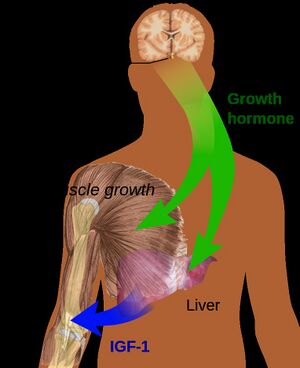Growth Hormone
Original Editor - Lucinda hampton
Top Contributors - Lucinda hampton and Vidya Acharya
Introduction[edit | edit source]
Human growth hormone (HGH), also known as somatotropin, is a 191 amino acid single-chain polypeptide. It is produced by somatotropic cells within the anterior pituitary gland.[1]
HGH is secreted in a pulsatory way, generally following a circadian rhythm. Various physiological stimuli can cause HGH secretion, the most influential, non-pharmacological being sleep and exercise.
HGH has numerous roles throughout life, from growth itself, including the turnover of muscle, bone and collagen, to the regulation of particular aspects of metabolic function for example increased fat metabolism and the maintenance of a healthier body composition in later life.[2]
IGF-1 is a hormone that manages the effects of HGH in the body. Together, IGF-1 and GH promote normal growth of bones and tissues.[3]
HGH Roles in Childhood and Adulthood[edit | edit source]
HGH acts on many parts of the body to promote growth in children. When the growth plates in the bones (epiphyses) have fused, HGH no longer increases height, but it still has important roles. In adulthood HGH impacts the bodies metabolism (how your body turns the food you eat into energy).
Growth: HGH induces growth in nearly every tissue and organ in the body. However, it is best known for its growth-promoting effect on cartilage and bone, especially in the adolescent years.
Metabolic Effects: HGH impacts metabolism primarily by up-regulating the production of insulin-like growth factor-1 and its subsequent effect on peripheral cells. Predominantly, cells move into an anabolic protein state with increased amino acid uptake, protein synthesis, and decreased catabolism of proteins. This leads to, for example, increased muscle mass. HGH also stimulates lipolysis, which is the breakdown of fatty acids in fat tissue. A 2015 review reinforces this, indicating that growth hormone-releasing hormone (GHRH) may be beneficial for people with obesity[4].[1] Additionally HGH indirectly acts on blood glucose levels through the regulation of IGF-1, which mimics insulin's effect in the body, helping control blood sugar levels.[5]
Sub Heading 3[edit | edit source]
Resources[edit | edit source]
- bulleted list
- x
or
- numbered list
- x
References[edit | edit source]
- ↑ 1.0 1.1 Brinkman JE, Tariq MA, Leavitt L, Sharma S. Physiology, Growth Hormone. InStatPearls [Internet] 2020 May 16. StatPearls Publishing. Available:https://www.ncbi.nlm.nih.gov/books/NBK482141/ (accessed 16.8.2022)
- ↑ Godfrey RJ, Madgwick Z, Whyte GP. The exercise-induced growth hormone response in athletes. Sports medicine. 2003 Jul;33(8):599-613. Available:https://pubmed.ncbi.nlm.nih.gov/12797841/ (accessed 16.8.2022)
- ↑ Medline plus IGF 1 Test Available:https://medlineplus.gov/lab-tests/igf-1-insulin-like-growth-factor-1-test/ (accessed 16.8.2022)
- ↑ Stanley TL, Grinspoon SK. Effects of growth hormone–releasing hormone on visceral fat, metabolic, and cardiovascular indices in human studies. Growth Hormone & IGF Research. 2015 Apr 1;25(2):59-65. Available: https://www.ncbi.nlm.nih.gov/pmc/articles/PMC4324360/(accessed 16.8.2022)
- ↑ Gilmore Health Role of HGH on Glucose Homeostasis in Humans Available:https://www.gilmorehealth.com/role-of-hgh-on-glucose-homeostasis-in-humans/ (accessed 16.8.2022)







